A Mid-Week Trip to St. Louis, Missouri
A vacuum at the Intersection of the Midwest and South
I sprained my MCL two weeks prior to this trip so in addition to missing the Chicago Marathon, I could not run the city. But we did ample walking and some scootin’.
As a child I visited the greater St. Louis, Missouri area with some regularity. My father was from there and he had family across the region. But by my early teens those trips stopped, so I hadn’t revisited in two-plus decades. What little space the city still occupied in my head was basically fading childhood memories, the Gateway Arch, and of course, nice people, urban decay, and White Castle – all Midwest staples. In returning, these Midwest stereotypes still showed themselves, but I was struck by how southern St. Louis really felt.
Just as the South and Midwest bleed together on the map, so too do the cultures, climate, and physical environments of these regions. And hot damn, does St. Louis ever feel like the exact middle of the two. It all blurs here. Geographically, it feels comfortably midwestern given that it’s a four and a half hour drive from Chicago to the North and under four hours to Indianapolis to the east. But it’s equally southern being that it’s also four hours north of Memphis and under a four hour drive east to Louisville.
Flying into St. Louis, the Arch dominates the skyline, standing out as a marvel of creativity unrivaled in the US. It illuminated what otherwise felt like a small and drab city. You could see the vacancy from above, almost like a model more than a living, breathing city. Once on the ground, the feeling of decay and neglect was immediate. The quietness that permeated the out of date airport was palpable but not all that surprising for a city of its size. But it was the ride through the city on I-70 and I-44 that made St. Louis feel like it had been left behind. These freeways were old and beaten, with lanes that felt too small for 70mph speed limits. They were likely the same size as in any other state but somehow they created an odd feeling of claustrophobia.
It was immediately apparent the shoulders were abbreviated, not providing nearly enough room to feel comfortable pulling over in an emergency. As I took note my driver pointed out a dead dog occupying this sliver of space while we barreled past. That was about what you could fit there. Highway shoulders covered in detritus is not that unusual. Pets though, a little less common.
In St. Louis the lanes themselves were a patchwork of garbage. It quite literally seemed as though people would bring their trashcans out on the highway to empty them. Oddly enough, I actually have a vivid memory of that exact thing happening as a very young child driving into St. Louis. We were on the freeway and pulled alongside a convertible occupied by a group, who were probably just teenagers, emptying full bags of trash onto the high with traffic around them. My dad was rolling down the window cursing and screaming “litter bugs!” at them while my brother and I sat in the back terrified. Being so young and brand new to any kind of illicit behavior, I was certain we would either be shot at or we’d see them on the news being put into prison. Instead they simply drove off laughing.
The strain of these cramped and trashed freeways was compounded by reckless driving. It became a running theme that every time we got on to the freeway, our drivers and those around us, immediately began driving with total abandon. Hard jerky moves replaced calm lane changes, riding bumpers replaced using the fast lane, and lead feet replaced gentle break taps. One driver mentioned that the Missouri Department of Transportation pays worse than any other state and that was a reason the highways looked the way they did, but it didn’t explain the bad driving. Maybe the haphazard look of the freeway was creating a collective subconscious of agitation that manifested as worse driving?
“Yeah, these people don’t give a shit around here, just let their dogs run onto the highway like that.”
What a wild statement, as if the owner being devastated couldn’t be a possible option. Since ‘these people’ is usually not a line that’s followed up by positive commentary, I kept my responses to the neutral ‘yeahs’ and head nods.
My driver stayed on the topic of dogs – man’s best friend, all the cliches. That felt like a comfortable conversation for me, until it was no longer about dogs. “They don’t talk back like people do. Nope, never an issue there, not like people that always want something from you, want to argue with you. It’s just me and my dog now, I like it that way.”
“Yep, dogs are great, I already miss mine,” I said, thinking of being at home with him right then.
I felt that even a hint of unintentional enthusiasm from my next response could move my driver from unsolicited commentary and headfirst into diatribes. So, I leaned on sports, the tried-and-true way to chat with anyone and avoid politics or world views. It’s the great equalizer.
“So, how’s the city—”
“—How’s it gotten so shitty?” He cut me off almost immediately. “Oh ha, I was going to ask how the city’s doing after the Cardinals playoff loss.”
“Well, this city’s really gone to shit. But I’m already over the loss, they blew it. I’m ready for hockey season.”
Before I could get a word in about hockey, he went on a rant about how the Cardinals had screwed up their game plan and how they wasted it for Pujols, Molina, and Wainwright. Yep, he was over it all right. Nevertheless, sports kept us occupied until he pulled up to the Soulard row house I’d be staying in. Sports had spared me from the worst and the house that awaited gave me hope as my friend Jake waved from a side balcony.
The air was thick and the lush overgrowth on the fences gave me feelings of the deep south. We were on a quiet street in the Soulard neighborhood, a mile south of downtown, though I’d later come to realize that just about all streets in St. Louis are quiet ones. Soulard is home to the largest Mardi Gras celebration in the US, outside of New Orleans. It’s a mix of haunting and enchanting homes and row houses from a couple centuries back, one part Chicago, one part French Quarter, complete with rickety second story balconies and overhanging oak trees. The quiet, open streets seemed ripe for filling with parades and celebration.
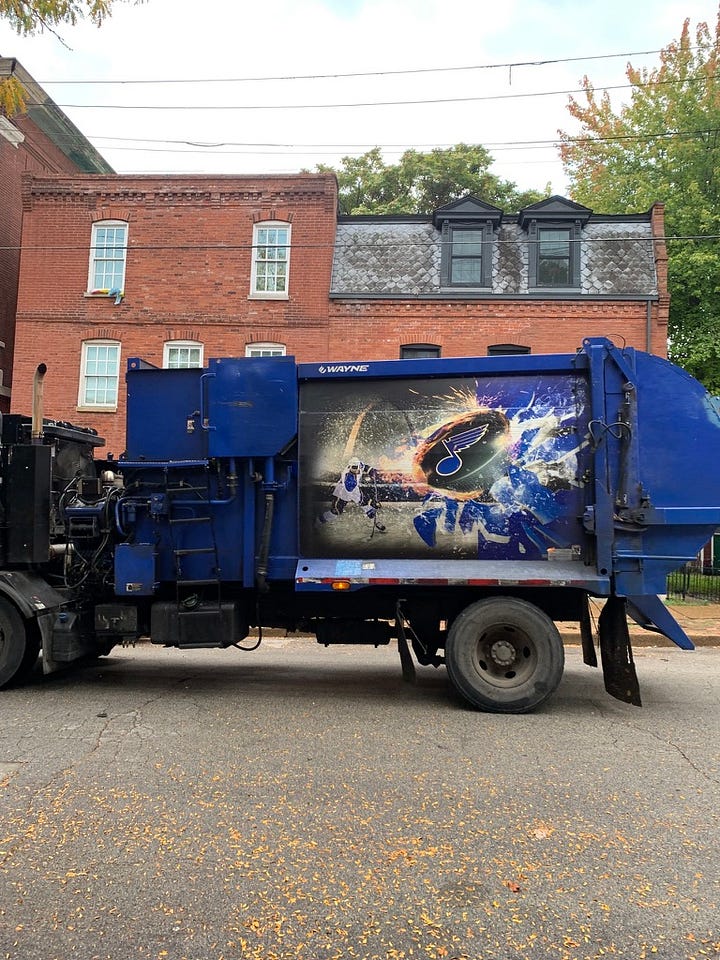

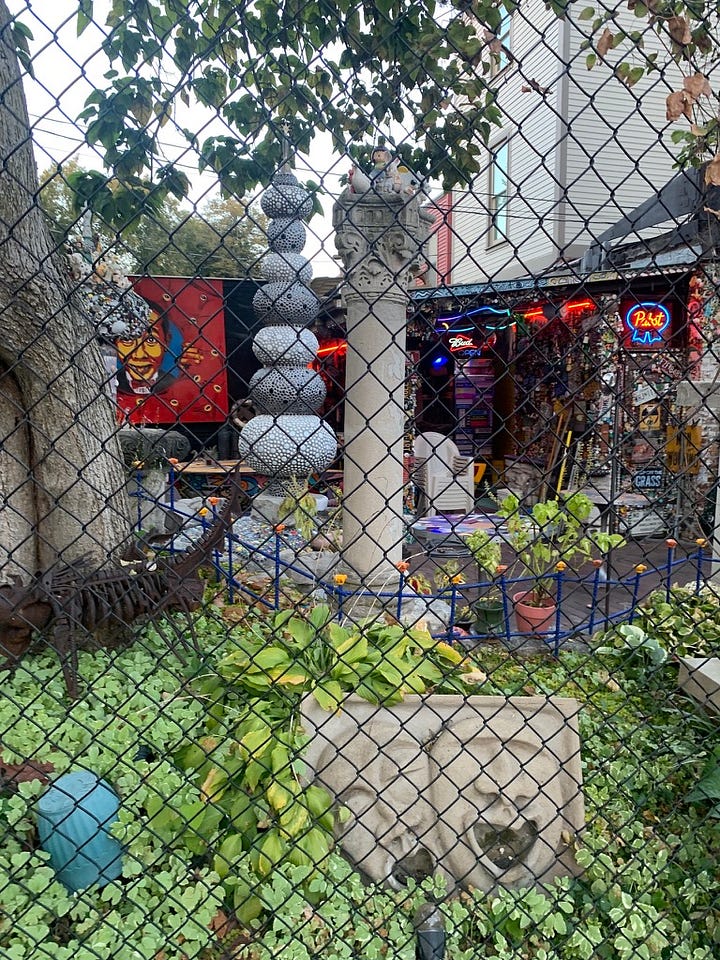
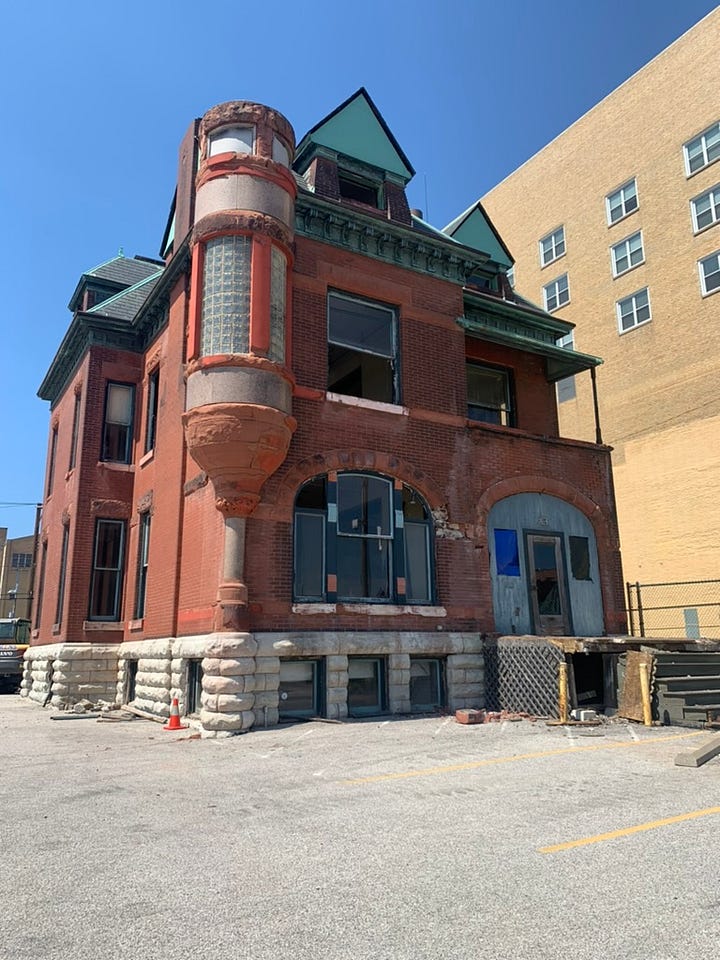
Our mile walk to the Venice Tavern was continuous empty streets and sidewalks, so much so that cottontail rabbits had taken over. They were omnipresent, like squirrels to most other cities. The emptiness would become the norm but at this point we wondered if it was simply because it was a Monday holiday.
The Venice was overwhelmingly kitschy, as advertised. There was brightly painted tile on sections of the floors, stairs, and walls, mixed with Mardi Gras flags and beads abutting Christmas tree decorations, and rice paper lamp shades. Outside were sea-shell tilings and fountains. Mobiles hung from the ceilings, happy meal toys lined walls, Halloween skeletons were hung next to Christmas lights. Where one mosaic ended another began. It felt as though it was run by a hoarder that had the focus and Adderall to turn their years of accumulation into the vision so many other pack rats could never articulate. But the noise on top of noise eventually muted itself. The atmosphere was subdued despite that visual affront, only a few tables were occupied. I can imagine the sensory overload being extremely fun in a lively setting but tonight was not the night. We drank our beers and headed off to Tower Grove.
Tower Grove South seemed to be a neighborhood for the younger crowd with a good strip of bars and restaurants along Grand Blvd. We popped into Terror Tacos to eat and found ourselves in what is now a very common mash up of vegan food and metal. The bar was absolutely blasting heavy metal, not like the heavy rock variety, more like deathcore, metal at its most intense. The menu looked like a series of band logos from Relapse Records and reminded me so much of this classic meme. The diversity of the crowd was the most unique factor. It was all walks of life, some very young, some a bit older, and the only metal heads were the people that ran the spot. Most people looked like maybe they were aware of Metallica, but nothing deeper than that, and yet were totally fine to block out the screams. They enjoyed their vegan burritos (which had an excellent Seitan meat substitute), and reasonably priced beer (local tall boys $6), as if there was no music at all.
Next was CBGB’s the punk bar up the street, and a bold name choice. There was no live music this evening and it was dead inside, luckily the back patio was sufficiently active. It was here that I received my first of many cans from a bartender unopened. I don’t think I’ve encountered this elsewhere, and while it makes no difference and is likely more sanitary, it somehow took away from the bar feel. It was as if I’d just reached into my own fridge.
The patio was occupied by a few groups, a single woman, and a Pitbull mix named Bob who roamed the patio eating scraps and getting pets. I came back from the bathroom (btw, one of them looks like this) and Bob was trying go into the bar as I went back out, so I shuffled him outside, letting the owners know. Then the single woman shared, “I don’t have a dog, I just have a rabbit at home.” I was intrigued and ready to hear what followed, but that’s all the information she gave. It was perfectly awkward.
Our night cap came at the Tick Tock Tavern – a neighborhood bar in an old brick building that had a front patio dotted with picnic tables, on a quiet stretch of brick colonial homes. The bar itself was a classic long top with a few tables at the opposite side with a couple giant living room spaces in the back. The elven punk rock bartender wore a beat up vest and a faded five panel cycling hat. He was gregarious and provided some semblance of energy in an otherwise subdued night. But the real highlight was that they served $6 Rye Manhattans all day, every day. That price is about $3 cheaper than what would be considered an already good price, and at least half off a standard anywhere on the East or West Coast. They were the ideal end to an early night.
Often the obvious tourist attractions of a city are usually wholly underwhelming (Space Needle, River Walk, Liberty Bell, etc). Or they’re just bad, either because of the amount of people and/or the total detachment from the place itself (Bourbon Street, Broadway Ave in Nashville, Chicago’s Navy Pier, Waikiki Beach). This however is not the case for Saint Louis. The Gateway Arch is likely the only thing people know about the city, and it bears that weight easily, not disappointing in the slightest.
It was an easy mile and a half walk from our place. When Soulard ended so too did most of the sidewalks. It was the typical edges of a downtown – highway overpasses, major thoroughfares, liquor stores, and stadium parking. This is where we hit the bygone era.
First was the block stretch of Purina. Yes, Purina pet food. In a world of flashy tech companies, it’s easy to forget these dated brands are still massive parts of local economies. I went on to learn that in 2001 Purina was acquired by Nestlé, and I went down that rabbit hole. Nestlé owns everything in the frozen aisle – Stouffer’s, Lean Cuisine, Hot Pockets, and Haagen-Daz. Also, Gerber. Oh, they have acquired yuppy things too – Perrier and San Pellegrino, and Blue Bottle Coffee. Hints of dog food wafted by as we walked on.
Prior to this trip the only company I associated with St. Louis was Budweiser, so I was blown away by Purina as staple. Then, to our surprise, right before we reached the Arch, we hit the Tums facility. Yep, that’s right – beer, pet food, and antacids. I don’t think you could dream up a better threesome.

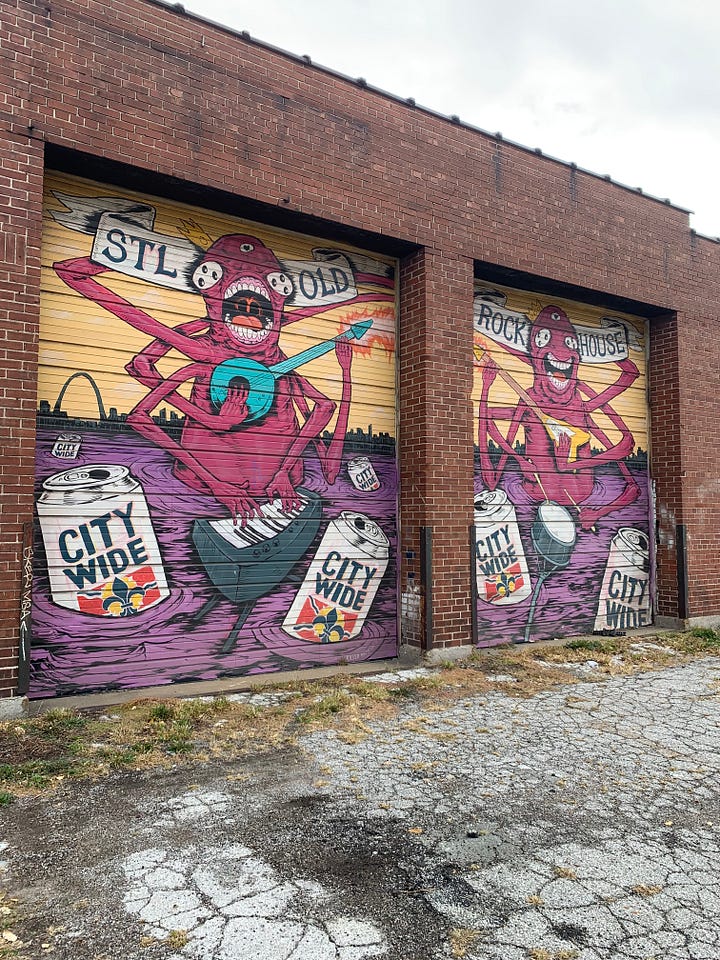
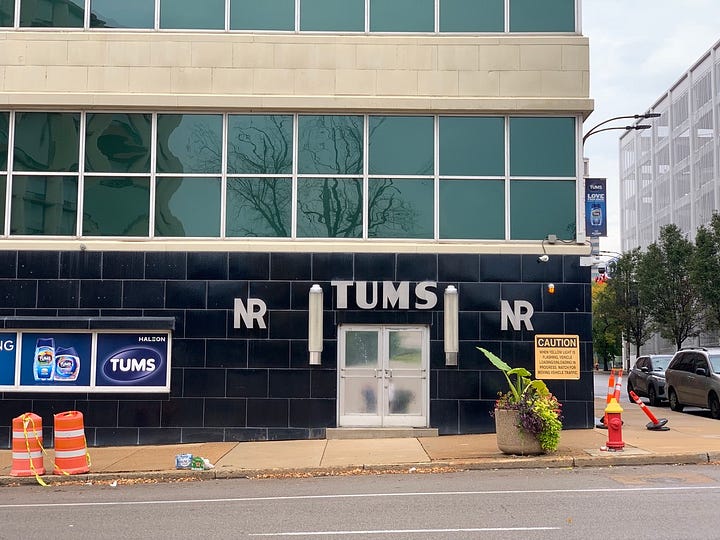
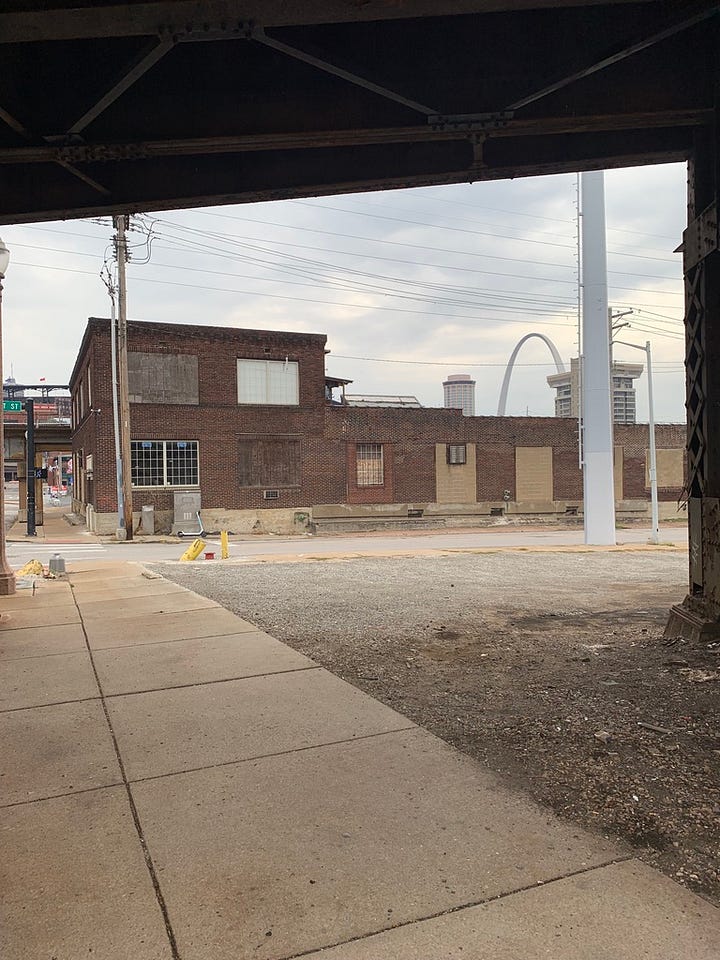
Across the street from Tums was the Millennium Hotel, an incredible eyesore. The Millennium is a complex with a 28-floor circular tower and an S-shaped ground floor building connecting it with a second 11-floor circular tower. It’s a look from the Sixties that doesn’t age well. They basically look like some modified version of air traffic control towers, with that same bleak prison-like exterior. Apparently it used to be called the Stouffer’s Hotel, so now I’m left to wonder if this was a Nestle brand hotel or a coincidence? The internet doesn’t specify.
Truth be told, given the lack of energy and vacancy we’d already seen, I thought this hotel was open. Turns out it had closed in 2014 (and for good reason). Sadly too, it seemed to embody the struggle of St. Louis. This property literally abutted the Arch and Busch Stadium (home to the BELOVED Cardinals) and yet it closed down and has sat abandoned for the last 8 years.
But what disappointment we had dissipated as we stood on the lawn of the Gateway Arch. It’s hard to state just how cool it is. It’s the tallest stainless steel monument in the world (and tallest memorial in the US) at 630 feet, which is also its width. The cross-section of the Arch is an equilateral triangle going from 54 feet wide at the base down to 18 feet at the top. There is just nothing that’s like it in the US or world. Its simple yet striking shape makes it feel infinitely classic. Never tacky, out of date, or of an era. And you’d think a shiny arch might be tacky on day one, but you’d be wrong.
At just 82-acres, it's also a National Park. When Jake asked me if it was one, I flat out dismissed him. Seconds later we saw the National Parks arrowhead logo. This, I believe, makes it the only National Park centered around a man-made entity? Which, in my estimation, gives credence to just how unique of a structure it is. We even saw the park ranger, dressed just like you’d see in Yellowstone, ready to provide the information on the latest bear sightings. In reality his job was likely more centered on people climbing or desecrating it. To the east is the Mississippi River and East St. Louis, IL, and to the West is downtown St. Louis and the regal Court House.
The reason the arch exists was to stimulate a post-Great Depression economy, revive the riverfront, and memorialize those who made possible westward expansion. With approval and funding, the city opted to have a contest to decide what design would be used as the architectural focal point. The hope was for something “transcending in spiritual and aesthetic values” as envisioned by Luther Ely Smith who had put the original idea of a memorial into motion.
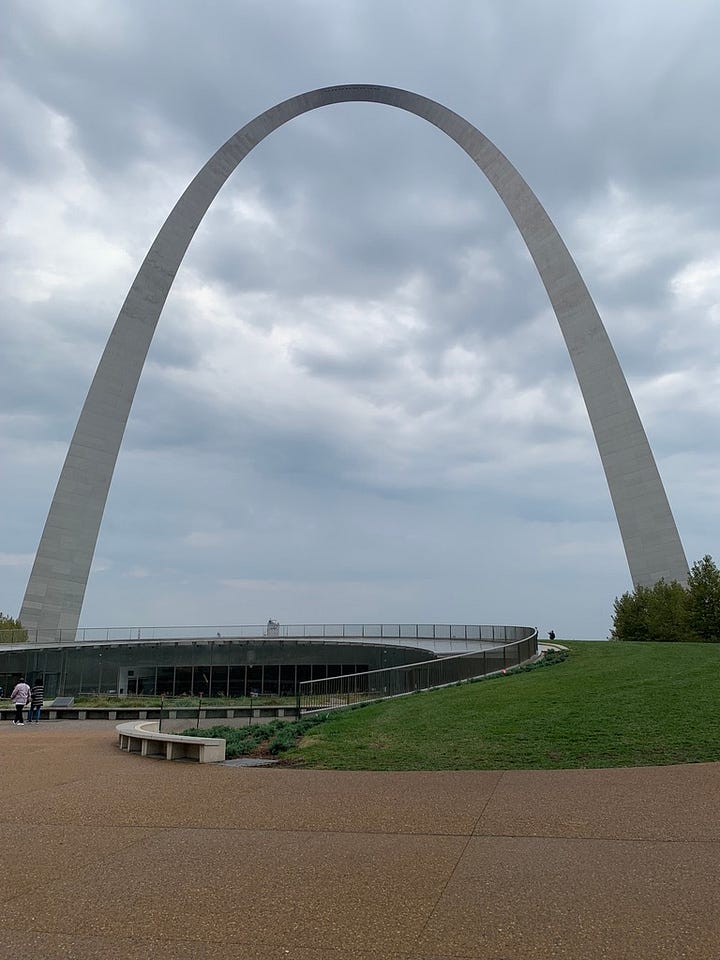
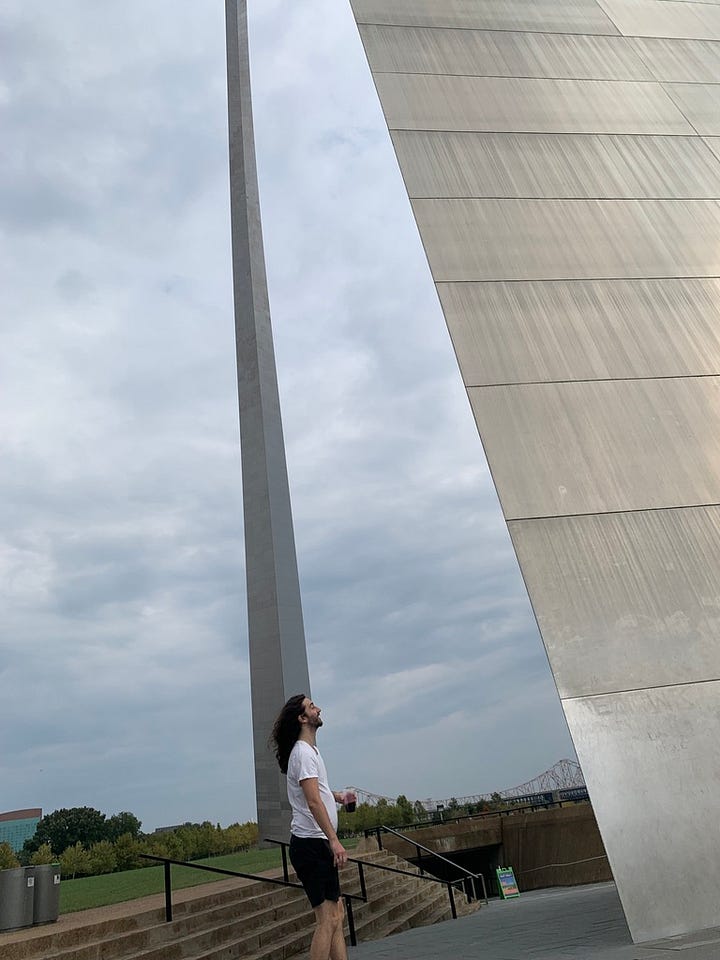
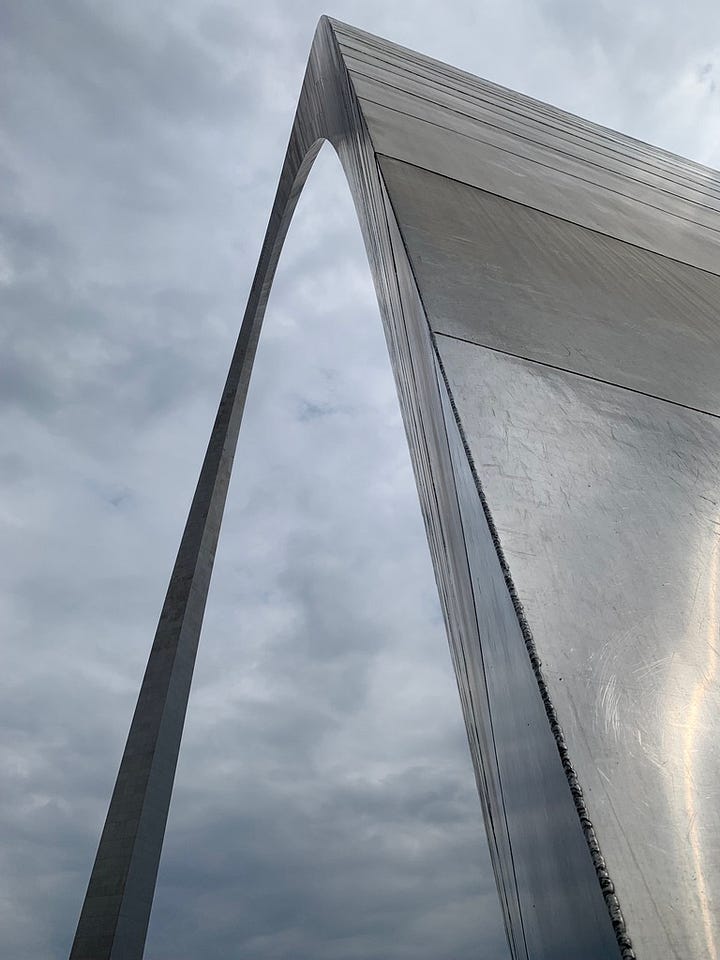
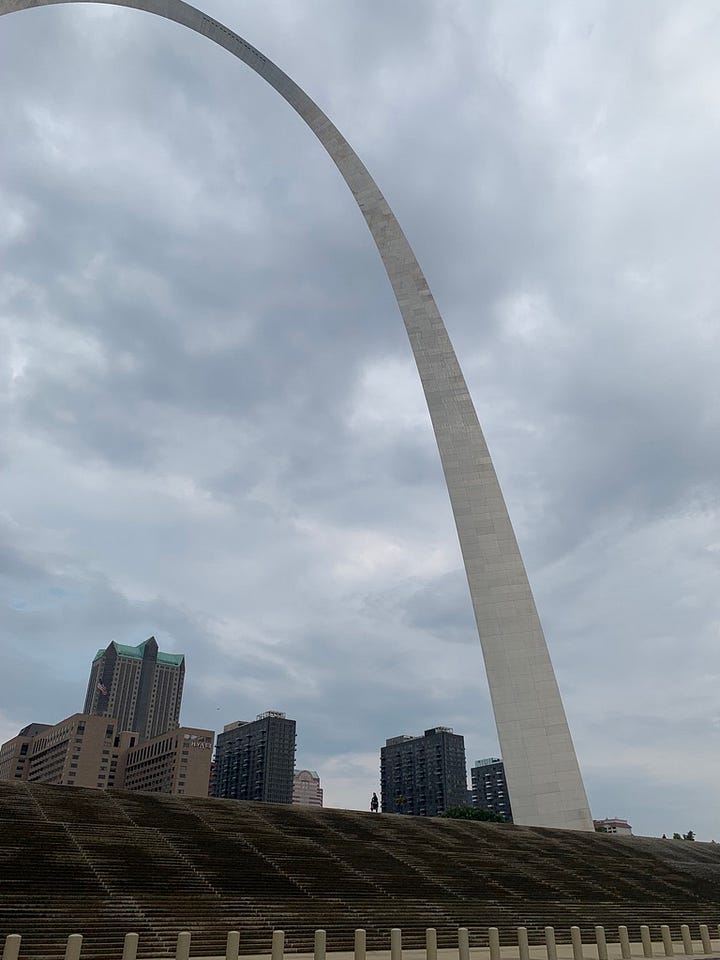
The unanimous winner of the contest was Eero Saarinen, son of Eliel Saarinen. Eero began as a furniture designer, working closely with Charles and Ray Eames (Eames chair anyone?). His most famous piece was the Tulip Chair, removing the clutter of legs and creating a stem-like base that was inspired by nature while also becoming synonymous with modern, industrial design. Other major building designs of his include the TWA Flight Center at JFK and Dulles Airport.
Though it may be a footnote now, when construction was finally underway in 1964, the Arch played a significant role in the Civil Rights Movement. On July 14th, two St. Louis civil rights activists, Percy Green and Richard Daly, climbed 125-feet up the north leg to expose the fact that black unions and workers were being racially discriminated against to work on construction of the federally funded project. Up to that point it had been kept to white workers. Leaving many details aside, this incident played a real role in pushing the federal government to enforce equal opportunity employment through federally funded job contracts by pushing this into the public eye. A year later its mark on history was permanent when President Lyndon B. Johnson signed an executive order the next year to prohibit federal contractors from discriminating against employees based on race, sex, creed, religion, color, or national origin. Much more on this can be found here and here.
With construction underway, Saarinen wanted a tram that could travel to the top of the Arch. With just two weeks’ notice, Dick Bowser, a college dropout with a family history in the elevator business, was contacted to create a way to the top of Arch. He developed what is basically an elevator system that moves in a diagonal fashion, to fit the shape of the arch. Each tram has 8 cars, each holding 5 passengers. And every car acts like a kind of Ferris Wheel cage, swinging as it goes up. It is an engineering feat within an engineering marvel. Oh, and there’ve been incidents of it malfunctioning. Nevertheless, an engineering feat. Beyond those, the arch has been used for illegal stunts throughout the years.
But some malfunctions and parachute stunts should not take away from the Gateway Arch as a premier US monument. It’s now nearly 60 years old and there’s still nothing like it, it has historical significance, and within its own architectural uniqueness lives a wild engineering design. It’s incredible, and if nothing else draws you to St. Louis, this honestly should. In terms of modern architecture, it sits as my highest praised tourist attraction.
Leaving the Park, we also saw the Wainwright Building in the distance. It was designed by Lewis Henry Sullivan and credited as the first building to successfully utilize steel frame construction. At best, it’s now considered one of the original skyscrapers, and at minimum “a common ancestor to every tall building that followed.” Sullivan became a mentor to Frank Lloyd Wright who stated, “It’s the very first human expression of a tall steel office-building as architecture.” Who knew St. Louis was so rich in architectural and engineering history?
From here we made our way north to the Cotton Belt Freight Depot, one of many massive, abandoned warehouses on the waterfront. Along the way we passed the saddest casino, the Horseshoe, and its partner in crime, the least luxuriant Four Seasons Hotel I’ve ever seen. It was more of the same too – empty streets and little activity – albeit more respectable in this instance as we were seeking out abandoned spaces on a Tuesday afternoon.

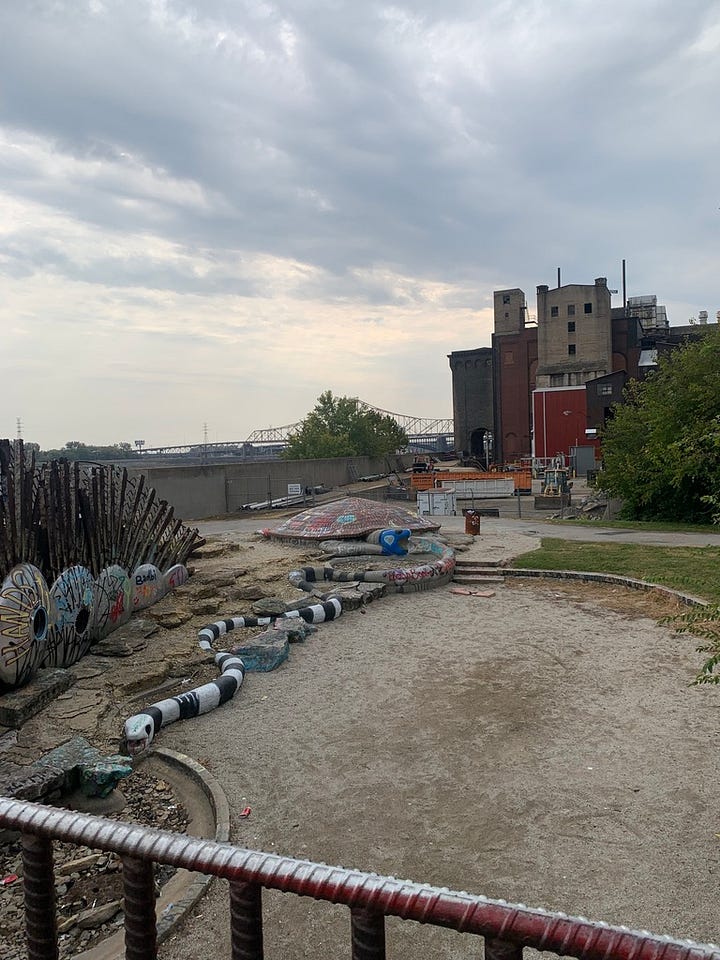

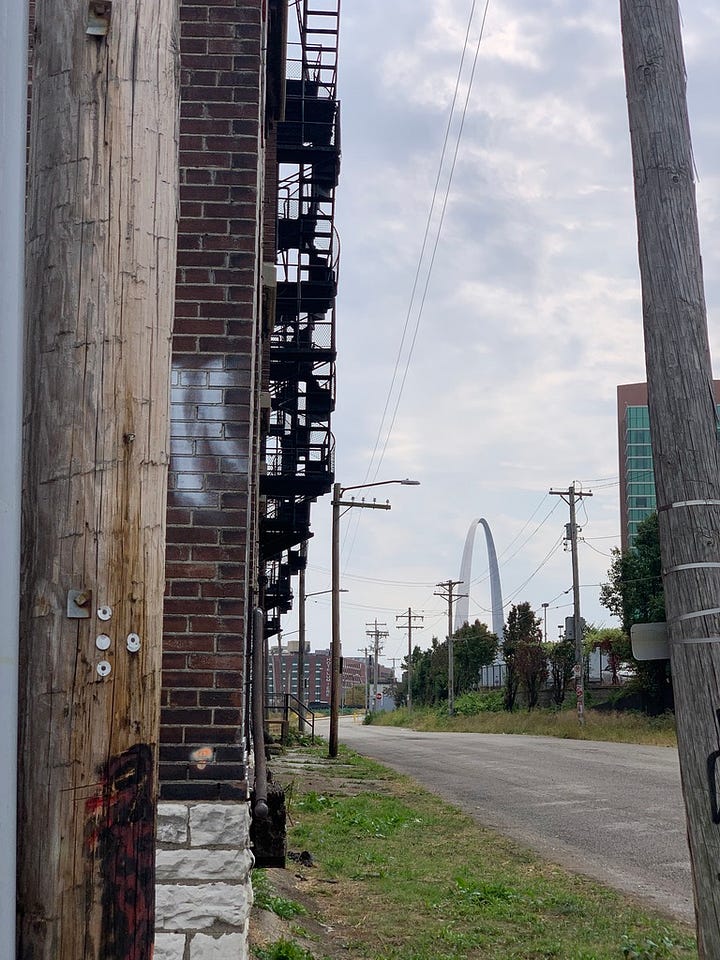
As we approached the Depot, we saw two people sitting on a grassy hill ahead. Behind them was a Subaru with its rack loaded up with bamboo branches and 2X4s. She was young and lively, and he was older, a bit of a rugged, friendly beatnik.
“Are you here for the festival?”
“No, we didn’t know there was one. Just here to check out all these buildings”
Apparently, we’d arrived at the final stage of clean up from the ARTICA STL festival. It’s a celebration of the creative spirit of St. Louis, spanning two days and featuring all types of artists and creators. It’s Bring Your Own Everything, with no money exchanged at all on the premises and free of charge. They were a couple of the founders and fed us the energy we were desperately looking for in the city. We chatted for a good while — they were ride or die for St. Louis talking up the affordability, the ability to own a home(s), work minimally, and focus on art and creative projects. They embodied what I’d expected to see in a city looking for a comeback.
Naturally, we got a handful of recommendations, but they came with a caveat. They asked how long we’d be in town, and we told them we were leaving Thursday morning. She could sense our eagerness to uncover livelier spots. “Well, the city really is quiet during the week…” It felt like the official confirmation that we were unlikely to see St. Louis at its best.
We poked around the warehouses which were city block sized canvases for murals. Being wedged between the Mississippi River and the highway created this no man’s land for the buildings to thrive in their decrepit state. People had created random sculptures and art out of what used to be little foot bridges, fences, and park spaces. Most interesting of all was the homeless community in and around the warehouses. In the case of the Depot (it’s an open air first floor beyond the support pillars), people had set up permanent dwellings. They used the pillars as guides for mapping out their spaces and then built actual fences around their dwelling (typically tents or ramshackle structures), but complete with private property signs and even dogs in the ‘yards.’
That afternoon we felt an obligation to go to the Budweiser Brewery and had a tour in mind but when we realized we could go directly to the onsite pub and drink straight from the source, that’s exactly what we did. Yes, it was fresh and delicious. And like any sane people we only drank Budweiser heavy, along with a sample of some yet-to-be-released beers. But no bud light for us, thank you.
That shit tastes like someone used artificial sweetener instead of malt. If you drink bud light, you can’t be trusted. In my eyes, you’re just another stoolie dipshit with the taste of a twenty-year old. And a twenty-year old is a person who thinks they know everything but in fact doesn’t understand life’s most basic concepts. Like taste. Literally every cheap beer is better than bud light.
Bud heavy? Just bring me the 12-pack. Coors light? Pour it from the heavens. Coors Banquet? Float me down the river. Miller High Life? Hook it to my god damn veins. Miller Lite? Bathe me in it, baby. Bud Light? If I were dying of thirst in the desert and all I had was a Bud Light, I’d wash my feet with it first. I’d be better off dead.
From there we opted to class things up. At some point on these trips you’ve got to shake things up a little, if only to give your brain a little palate cleanse. Plus, our attempts to find any gathering of young people was coming up short so Little Fox, the esteemed Italian restaurant tucked away in residential neighborhood seemed as good as any.
And wow was this place a good change of pace. It’s got the accolades — a 2021 feature in the New York Times “Restaurant List” and a semi-finalist for a James Beard award in 2022 — and it lived up to the hype. We did some combo of apps and small plates that included Cannellini Crostino, grilled Royal Trumpet mushrooms, and a Cavatelli pasta dish. But the real gem for me was the Stracciatella.
I am not a bougie foodie, but my understanding is the Stracciatella is an Italian soup. This was not that. It was a squash puree with a creamy mozzarella on top, finished with micro leeks, fish roe, lemon oil and crusty bread on the side. It sounds simple, it was simple, and it was also divine. They sat back and let the ingredients do the work. It was the perfect balance of sweet and salty, without fabricating either. The texture was satisfying crunch in harmony with airy softness. Couple that with a few negronis on a breezy porch and you’ve got a damn good meal. While the restaurant filled out, the young people remained at large. I ordered us a car to head over to Pop’s Blue Moon, a good lookin’ dive with nightly live music.
When the Chevy Trax pulled up it looked a little worn in. When I got in the car I was hit with a vicious stench. Upon sitting down I realized that maybe I was sitting in it. I immediately thought, I should not be in this car, but I had only a split second to make the decision to bail and didn’t. The smell was some combination of literal garbage and dirty dog. That overwhelming dog-scent you get at the kennel or rescue where the dogs are never getting bathed, shit is accumulating around them, and they sleep on unwashed beds that hundreds of other dogs have slept on. It was pungent and baked in. We were sitting on some kind of seat cover, but it appeared to have been sullied by the dogs and perhaps something more sinister.
The driver was chatty and friendly which was a nice distraction insomuch as it was a form of distraction. I rolled down my window and after a few minutes accepted the smell as a reality of my immediate situation. I took a better look around. The windshield was horrifying. It had that smeared look where a dog presses their nose against a window, but this was the entire windshield, top to bottom. It cut visibility in half. And then, sitting in the front seat, was some kind of giant tub, probably 4-feet tall and 2-feet wide, covered in massive black garbage bags. What was our driver disposing of?
The merciless 8 minute ride ended at Pop’s with our driving saying “Hey, you guys were really great passengers, I’ll be sure to rate you 5 stars. I hope I was a great driver too. Can you rate me 5 stars? I’d really appreciate it.” He got 3 stars and $2 dollar tip. That’s 5 things he didn’t deserve. There’s something amiss when someone stops just shy of begging for a single positive rating.
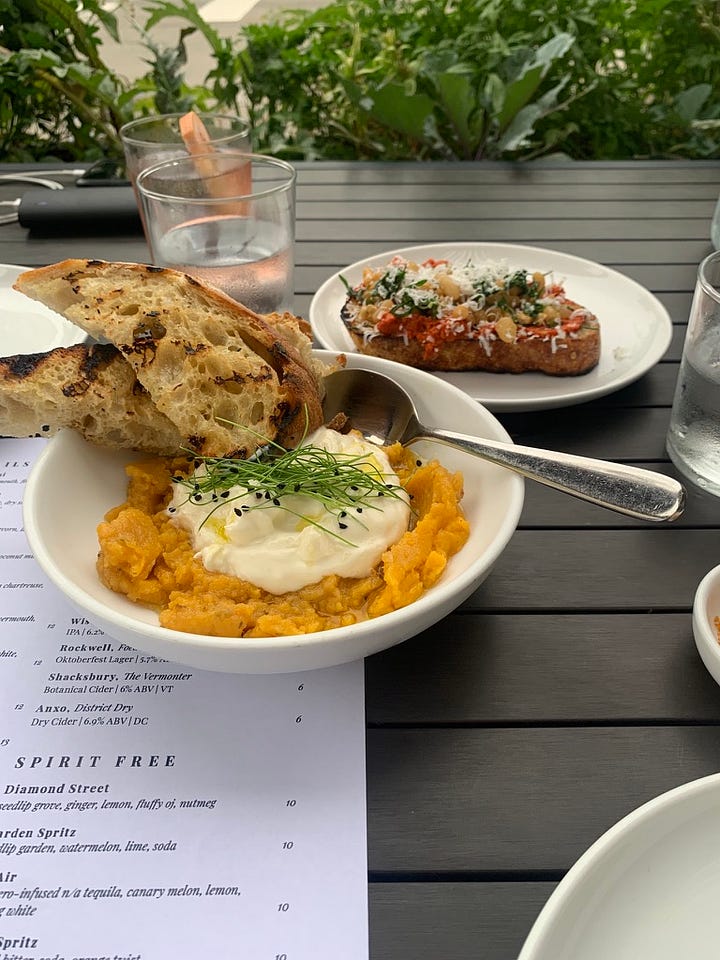
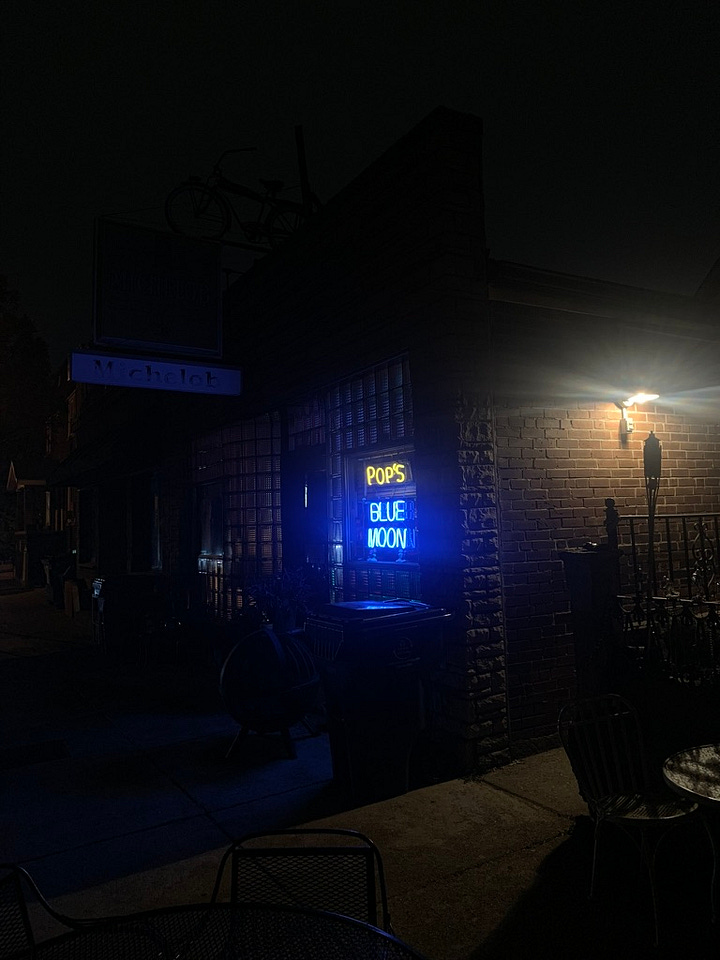
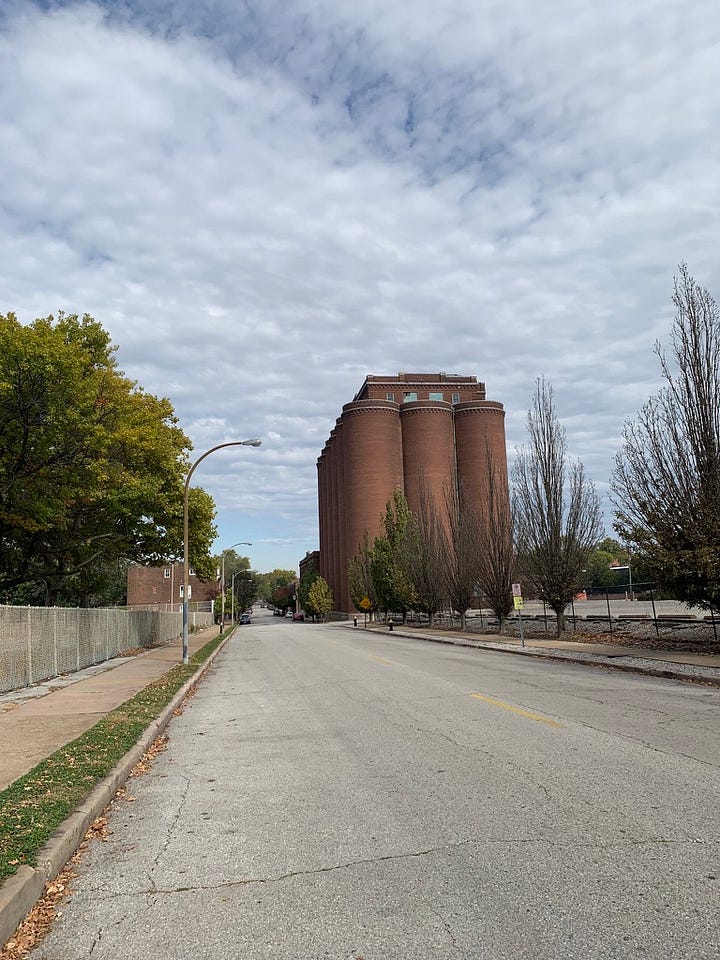
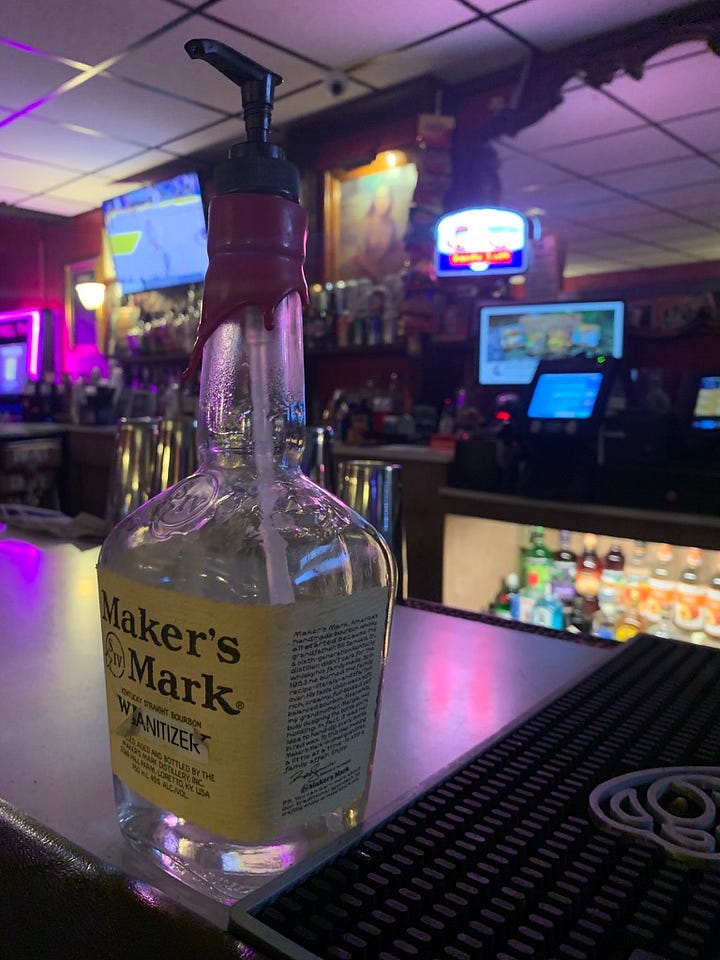
Pop’s had the feel of a special place. It’s bizarrely located on a service road parallel to the highway and it’s the only business in sight, everything else is residential. These literal neighborhood bars are often a prize to uncover. The façade was a limestone like brick exterior with glass block windows and two smaller windows adorned with neon signs. Small and unassuming. We walked in and what do you know, we were the only two people at the bar. Well, not that’s not entirely true. It was us and the two-piece band who were finishing their drinks and about to take the stage.
We chatted with the bartender, it was Pop himself, about St. Louis and what to do around the city. He didn’t give us a straight answer as to whether the lack of people was standard, if it was just early week slowness, or due to the fact we were coming off a 3-day weekend. I wasn’t encouraged when he suggested a couple of bars we’d already been to and had found eerily quiet. We finished our beers right as the band started, extricating ourselves before there might be an expectation to stay as their audience of two.
We walked over the highway to the center of the Hill, a prominent Italian neighborhood thanks to a very strong preservation of the culture and former residents like Yogi Berra. There was evident pride all around with some of the crosswalks made into the Italian flag. We hit Milo’s Tavern an institution in the neighborhood since the turn of the last century and wildly popular for their bocce courts. It’s so much a St. Louis staple that in 2019, when the Blues won it all, the Stanley Cup made sure to pass through for beers. And would you believe it? The place was packed on a Tuesday. Sure, it was mostly older men. But still, PEOPLE.
Bocce was the draw. There are two courts outside, and a space for tables between them, with a roof over it. It felt like a stable but no horses, just boisterous men. Lining the edge of the courts were the outdoor tables for onlookers like us. While we wanted to play, the line looked exceedingly long. We were content to watch and soak up the energy of the game. It was an ideal neighborhood bar that clearly served this community well.
From here we walked a mile to the Hideaway Tavern. It’s labeled as a piano bar, though that vibe wasn’t really apparent. But it was trivia night, and while we got there towards the end of the game, it did draw some people in. Hideaway had the classic dive signature of low, dropped ceilings you might find in a crappy strip mall office, and carpeted floors. It was comfortable but otherwise unremarkable, save for the hand sanitizer bottles made from Maker’s Mark bottles placed along the bar. Well, that and the sign for $10 Natty buckets, all day, every day.
We posted up for the long haul and tied on a serious buzz. The moment that I decided this was a proper dive was when the bartender, who had otherwise been jovial and attentive, began snaking a drain behind the bar. This was without warning to anyone. Not only was it loud, but it smelled like a clogged pipe might. Unpleasant.
I leaned over the bar to see what was happening, shouting, “What’s goin’ on?”
It took her a second to register that someone was curious about the unannounced noise and stench overtaking the room. “Oh, just snaking this drain, there’s a clog. We’ll be done in just a second.”
“Uhm. Ohh.” We shot each other looks and stared on in silence. I grew concerned about what this might be stirring up, putting out into the air, on the bar, and in the ice. All the same, we never left our seats, just sat in silence for a bit until the moment passed and we could focus our attention on anything else. The night wrapped with me taking over the juke box and unnecessary shots that did nothing other than make the next day harder. Typical.
Hungover, we still made it out the door in pretty good time that morning. We hit the same spot we had the previous day, Goshen Coffee Roasters. It was just down the street and a perfect respite, not just for a hangover, but for a city that confounded me, though in many ways it did embody St. Louis perfectly. After all, it’s an entire two story building, complete with an upstairs patio and backyard garden for seating. An obscene amount of space for a coffee shop. This can only fly in a city where occupied buildings seem to be outnumbered by the abandoned. That said, the brightness of the space, people, and even the food and drink, did sit in contrast to a city feeling lethargic.
The drip coffee was light and punchy and the avocado toast was a brilliant array of colors with pickled red onions, radish, carrots, and red pepper flakes dressed over the avocado spread. A lot of people swear by heavy, grease bomb food when hungover, which has its place if you’re going back to bed or prepping to melt in front of the TV. But if you want any shot at salvaging the day, especially when traveling, going healthy but filling is always the move. Giving yourself some vitamins, minerals, and antioxidants via fresh food is only fair. The heavier can always come later.
From here we hopped on scooters to see more of the city. We went south which in retrospect was bound to be a bit more barren. We were staying on the eastern most side of the city so going west, where the city expands, would have provided more to see, but I had to see my dad’s newly placed headstone in Jefferson Barracks, an Army Base and National Cemetery. We passed Cherokee street, a strip known for bars and restaurants (when we walked through during the previous afternoon, every bar was closed), the old Lemp Brewery, and Off Broadway, a well-loved independent venue.
After those landmarks it was desolate. Though, to be fair, we were staying on a main thoroughfare and passing the edges of a couple cool looking neighborhoods. Regardless, it was a depressing stretch that added a distinct hollowness to my first visit to my dad’s grave. The long expanses of emptiness the city offered seemed to mirror the vacancy of losing a family member.
But it was more than that. My Dad was born in St. Louis in 1952, at the peak of the St. Louis population (850,000). Like so many cities that saw suburbanization and white flight take hold, it’s been in steady decline ever since. In fact, the city has lost 64% of its population over the span of my dad’s life (now 301,000). That’s the most of any US city with a population of at least 100,000 people. Even more than Detroit, the poster child of gutted American cities. In addition to losing my dad, I felt I was also witnessing the loss of the place that had for so long has represented him and his childhood. A whole world I was just reintroduced to seemed to be crossing a point of no return. It felt defeating to see all that can come and go in 70 years time.
Luckily our day began to rebound when we hit 4 Hands Brewery in LaSalle Park, tucked between Soulard and Downtown. We’d been grabbing their beer at most of our bar stops and none at the brewery disappointed. While it was quiet, the vibe was good and it was another piece of evidence that showed on the right night St. Louis might have a distinctly different feel. And the spicy fried fish sandwich from Peacemaker, which operates their food menu, was a the perfect compliment to a few pints.
Planter’s House was the next stop, it’s that classic warm and inviting but unpretentious gastropub and cocktail bar. The walk there began as more of the same — quiet streets, beautiful row houses, both abandoned and cared for, empty bars, closed restaurants, gas stations, and fast food. But the atmosphere changed immediately after walking over the garbage strewn interstate, by way of Mississippi Ave, and into Lafayette Park.

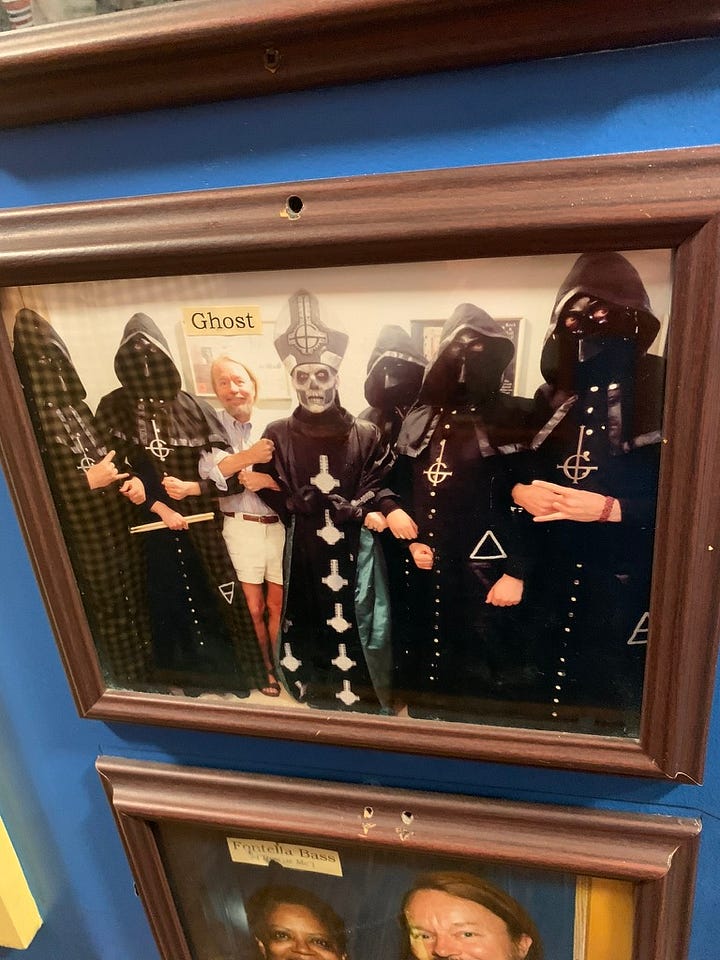
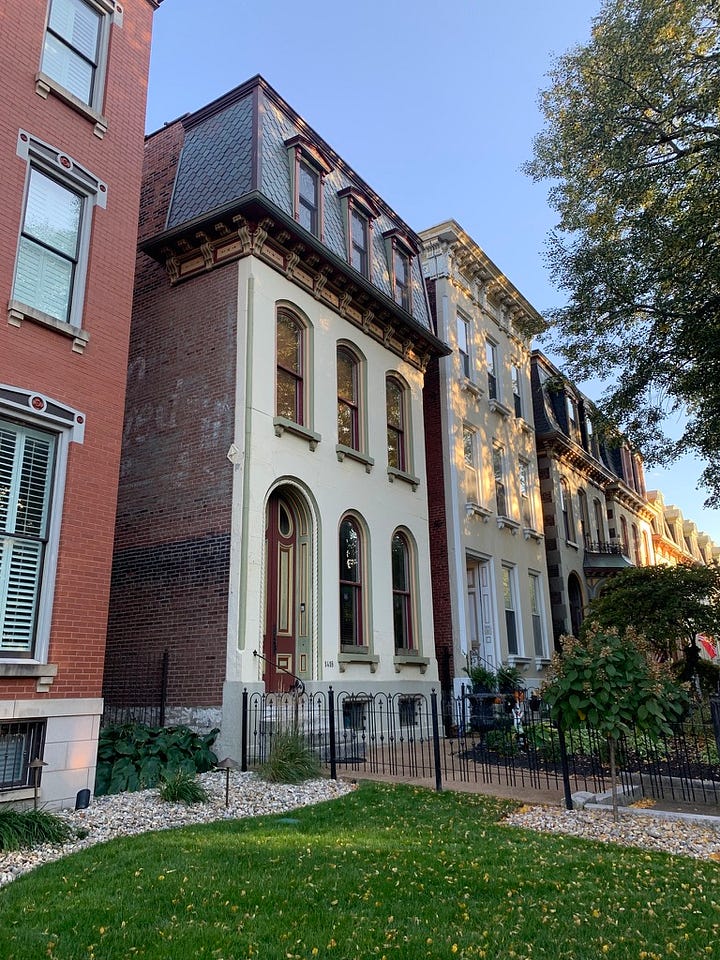
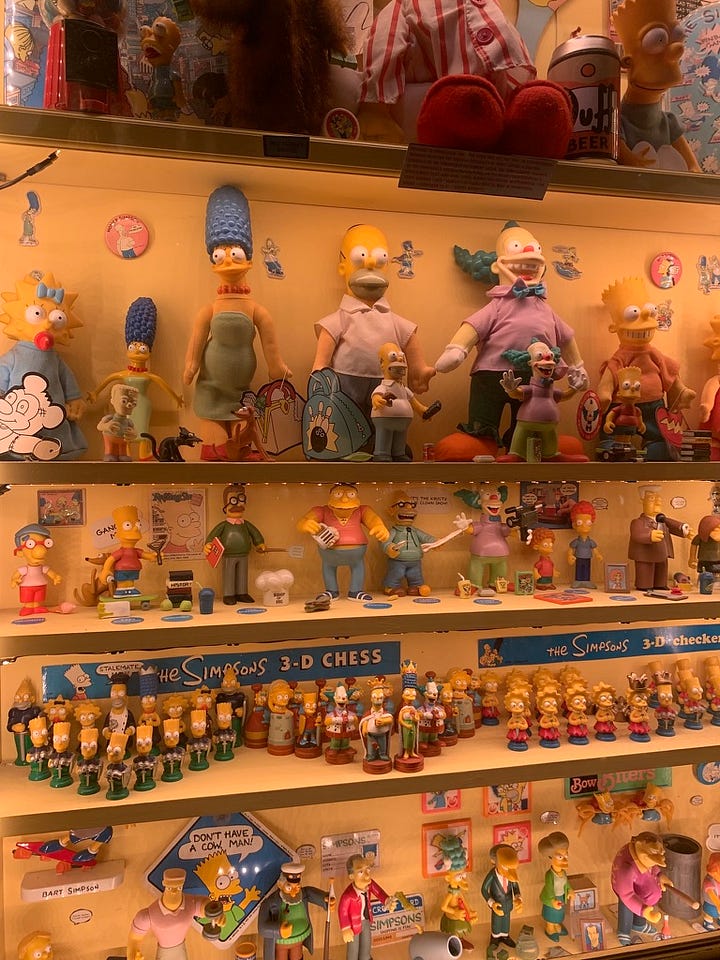
Yards were now well kept; no homes were deserted or in disrepair. Now everything was manicured, and people were out. In other words, there was more money here. It felt like New Orleans’ Garden District with its restored Victorian homes met the row houses of Chicago’s Lincoln Park. I’d be lying if I said I didn’t enjoy the setting change. The vibe at Planter’s was upbeat – a mix of dates, the after work crowd, and casual drinkers filling the main bar and patio. We enjoyed some evening sunlight and a quick cocktail before heading to the Delmar Loop.
The Loop is one of the hipper and more well-known strips in the city thanks to an influx of college kids from Washington University just a block away, and a few longstanding spots like the record store Vintage Vinyl, concert hall the Pageant, and the restaurant, bar, and venue, Blueberry Hill. The latter is where we went. The place was buzzin’ and the drinks were flowing, though it is family friendly (at least until 9p). Downstairs is a venue, The Duck Room, which had a show that night, adding a stream of people snaking their way through the bar.
We ordered beers and burgers, and of course, the traditional fried goodness staple of St. Louis: Toasted Raviolis. These are just like they sound, fried raviolis (apparently the St. Louis standard is with meat, but cheese only is an option too) with marinara for dipping. They should be a bar food option nationwide. And while they are not, I’m lucky enough to live next door to a spot in Portland that does have them (shout out to Bar Bar)!
Blueberry Hill is packed with kitsch and pop culture memorabilia like collectables, figurines, toys, and action figures as well as guitars, taxidermy, and beer and sports memorabilia. But the best attraction is the wall of pictures dedicated to the musicians that have either graced the Duck Room or Pageant stage, and other celebrities who have dropped in to see Blueberry Hill for themselves. Each one is with owner, Joe Edwards. But from what I could tell their walls spanned decades and was still going strong today. From Nelly and Kanye, to Mitch Hedberg and Maya Angelou, he’s met them all. Whoever your favorite artist is, you’re likely to find them somewhere along these walls.
Edwards opened Blueberry Hill in 1972. In 1997, he added the 240-cap Duck Room below the restaurant. It made a name for itself hosting national acts as well as regularly opening the stage to St. Louis native, and the creator of Rock’n’roll himself, Chuck Berry. He played there over 200 times. Edwards went on to re-open the Tivoli theatre, establish the St. Louis walk of fame, and the Pageant, making the Loop a destination neighborhood for tourists and locals alike. It is this entrepreneurial mindset and love for the city that’s as good a blueprint as any for other neighborhoods of St. Louis to follow. Edwards’ dedication to celebrating and revitalizing the area has shown exactly what St. Louis can be.
Our final stop was the Grove, another small strip dense with bars and restaurants, and again bolstered by a school nearby – University of St. Louis. We hit the Gramophone, it’s positioned as a sandwich shop first, and they do have a proper sandwich menu, but it’s a bar at its core. There were people from all walks of life hanging out and mingling. Some people were there solely for a sandwich, but most were taking advantage of the full bar and excellent beer menu, pool, and pinball. Ending the trip here had us brushing past a piece of the St. Louis revelry we were seeking, but it was too little, too late.
An idea I’ve stood by in travel is that a city should show its true self no matter when you visit. You shouldn’t have to be there on the weekend or in high season to get a good sense of the place. You should get a real taste of it, and a sense of the potential, at any point in time. St. Louis beamed with possibility but left me unsated.
If my theory holds true, did we see St. Louis for exactly what it is – a sleepy hollowed out city? Or did the timing set us up for failure? It certainly felt off from the jump. Even those with serious St. Louis pride said as much. But they also gave me optimism — they were a part of the framework that could make St. Louis into a dynamic alternative city to visit. You can live well on a lot less there – the typical trigger for a bohemian arts culture to spring to life. Prime real estate is plentiful, the universities are well established, there’s a growing food and beer scene, and it’s geographically close to so many other major cities. The groundwork for a renaissance is there. But I think it will require an influx of people for it to be fully realized — likely more transplants coming in while students plant roots and locals get reinvigorated.
As a lover of overlooked cities, I’m here for it. I only wish I had more of the gospel to spread in the present.



This rocks. Read it in chunks over the course of a few hours and took me back to the feeling of road tripping across much of the US: delighting in the innocuous and small details, while keeping the booze flowing. Great essay man, looking forward to more!
Nice take on my native STL! You hit up some of the most acclaimed spots, and I think your vibe check of STL compared to other cities is pretty accurate—a little quiet, spread out, known for its crime (which is why our highways have a bit of a wild west feel...cops are a little busy doing things other than sitting and handing out speeding tickets), not crowded (and therefore incredibly cheap to live in), and a little scrappy. But, there are still many other cool neighborhoods, attractions, places, and local flare to check out next time you're there!